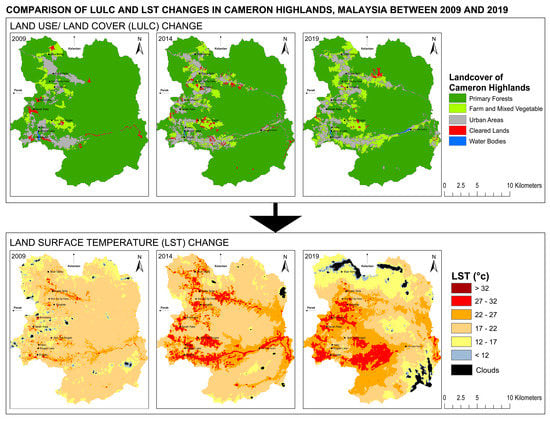Land Use/Land Cover Changes and the Relationship with Land Surface Temperature Using Landsat and MODIS Imageries in Cameron Highlands, Malaysia
Abstract
1. Introduction
2. Materials and Methods
2.1. Study Area
2.2. Remote Sensing Image Acquisition
2.3. Land Use/Land Cover Change Mapping
2.4. Classification of Images for LULCC
2.5. Land Surface Temperature (LST) Calculation
2.5.1. Conversion of Digital Numbers to Top-of-Atmosphere (TOA) Spectral Radiance
2.5.2. Conversion of Radiance to Brightness Temperature
2.5.3. Atmospheric Transmittance
2.5.4. Emissivity Estimation Using the NDVI Technique
2.5.5. Calculating the Proportion of Vegetation (Pv)
2.5.6. Land Surface Emissivity (LSE) Assessment
2.5.7. LSE Mean and Difference
2.5.8. Derivation of Atmospheric Vapor Pressure Content (W)
2.5.9. Land Surface Temperature (LST) Derivation
3. Results and Discussion
3.1. Land Cover Change Analysis
3.2. Land Surface Temperature Change Analysis Based on Landsat Satellite Data Compared to MODIS
3.3. Air Temperature against Landsat and MODIS.
3.4. Verification of LST
3.5. The LULC Effect on LST
4. Conclusions
Author Contributions
Funding
Conflicts of Interest
References
- Kumaran, S.; Ainuddin, A.N. Forest, water and climate of Cameron Highlands. In Proceedings of the Seminar on Sustainable Development of Cameron Highlands, Brinchang, Cameron Highlands, Malaysia, 11–12 December 2004; p. 11. [Google Scholar]
- Jin, M. Analysis of land skin temperature using AVHRR observations. Bull. Am. Meteorol. Soc. 2004, 85, 587–600. [Google Scholar] [CrossRef]
- Hardwick, S.; Toumi, R.; Pfeifer, M.; Turner, E.; Nilus, R.; Ewers, R. The relationship between leaf area index and microclimate in tropical forest and oil palm plantation: Forest disturbance drives changes in microclimate. Agric. For. Meteorol. 2015, 201, 187–195. [Google Scholar] [CrossRef] [PubMed]
- Knight, J.; Harrison, S. The impacts of climate change on terrestrial Earth surface systems. Nat. Clim. Chang. 2012, 3, 24–29. [Google Scholar] [CrossRef]
- Beniston, M. Mountain Environments in Changing Climates; Routledge Publishing Company: Abingdon, UK, 1994; p. 492. [Google Scholar]
- Wolff, N.; Masuda, Y.; Meijaard, E.; Wells, J.; Game, E. Impacts of tropical deforestation on local temperature and human well-being perceptions. Glob. Environ. Chang. 2018, 52, 181–189. [Google Scholar] [CrossRef]
- Cong, R.; Brady, M. The interdependence between rainfall and temperature: Copula analyses. Sci. World J. 2012, 1–11. [Google Scholar] [CrossRef] [PubMed]
- World Meteorological Organisation. Climate and Land Degradation. Soil conservation—Land Management—Flood Forecasting—Food Security. WMO—No 989. Available online: http://www.wamis.org/agm/pubs/brochures/wmo989e.pdf (accessed on 17 December 2019).
- Berg, P.; Moseley, C.; Haerter, J. Strong increase in convective precipitation in response to higher temperatures. Nat. Geosci. 2013, 6, 181–185. [Google Scholar] [CrossRef]
- Avdan, U.; Jovanovska, G. Algorithm for automated mapping of land surface temperature using LANDSAT 8 satellite data. J. Sens. 2016, 1–8. [Google Scholar] [CrossRef]
- Darge, Y.; Hailu, B.; Muluneh, A.; Kidane, T. Detection of geothermal anomalies using Landsat 8 TIRS data in Tulu Moye geothermal prospect, main ethiopian rift. Int. J. Appl. Earth Obs. Geoinf. 2019, 74, 16–26. [Google Scholar] [CrossRef]
- Sahana, M.; Ahmed, R.; Sajjad, H. Analysing land surface temperature distribution in response to land use/land cover change using split window algorithm and spectral radiance model in Sundarban Biosphere Reserve, India. Modeling Earth Syst. Environ. 2016, 2. [Google Scholar] [CrossRef]
- Cristóbal, J.; Jiménez-Muñoz, J.; Prakash, A.; Mattar, C.; Skoković, D.; Sobrino, J. An improved single-channel method to retrieve land surface temperature from the Landsat-8 thermal band. Remote Sens. 2018, 10, 431. [Google Scholar] [CrossRef]
- Montanaro, M.; Lunsford, A.; Tesfaye, Z.; Wenny, B.; Reuter, D. Radiometric calibration methodology of the Landsat 8 thermal infrared sensor. Remote Sens. 2014, 6, 8803–8821. [Google Scholar] [CrossRef]
- USGS1. Using the USGS Landsat 8 Product. 2018. Available online: https://www.usgs.gov/media/files/landsat-8-data-users-handbook (accessed on 25 April 2019).
- USGS2. Landsat 8 (L8) Operational Land Imager (OLI) and Thermal Infrared Sensor (TIRS). 2018. Available online: http://landsat.usgs.gov/calibration_notices.php (accessed on 25 April 2019).
- Al Kafy, A.; Al-Faisal, A.; Mahmudul Hasan, M.; Sikdar, M.; Hasan Khan, M.; Rahman, M.; Islam, R. Impact of LULC changes on LST in Rajshahi district of Bangladesh: A remote sensing approach. J. Geogr. Studies 2020, 3, 11–23. [Google Scholar] [CrossRef]
- Ogunode, A.; Akombelwa, M. An algorithm to retrieve land surface temperature using Landsat-8 dataset. South Afr. J. Geomat. 2017, 6, 262. [Google Scholar] [CrossRef]
- Rozenstein, O.; Qin, Z.; Derimian, Y.; Karnieli, A. Derivation of land surface temperature for Landsat-8 tirs using a split window algorithm. Sensors 2014, 14, 5768–5780. [Google Scholar] [CrossRef] [PubMed]
- Sajib, M.; Wang, T. Estimation of Land Surface Temperature in an agricultural region of Bangladesh from Landsat 8: Intercomparison of four algorithms. Sensors 2020, 20, 1778. [Google Scholar] [CrossRef]
- Wang, L.; Lu, Y.; Yao, Y. Comparison of three algorithms for the retrieval of land surface temperature from Landsat 8 images. Sensors 2019, 19, 5049. [Google Scholar] [CrossRef]
- Zhou, D.; Xiao, J.; Bonafoni, S.; Berger, C.; Deilami, K.; Zhou, Y.; Frolkin, S.; Yao, R.; Qiao, Z.; Sobrino, J.A. Satellite remote sensing of surface urban heat islands: Progress, challenges, and perspectives. Remote Sens. 2018, 11, 48. [Google Scholar] [CrossRef]
- Mejbel Salih, M.; Zakariya Jasim, O.; Hassoon, K.I.; Jameel Abdalkadhum, A. Land surface temperature retrieval from LANDSAT-8 thermal infrared sensor data and validation with infrared thermometer camera. Int. J. Eng. Technol. 2018, 7, 608. [Google Scholar] [CrossRef]
- Nemani, R.; Running, S. Estimation of regional surface resistance to evapotranspiration from NDVI and Thermal-IR AVHRR data. J. Appl. Meteorol. 1989, 28, 276–284. [Google Scholar] [CrossRef]
- Akmar, C.K.; Mohd Hasmadi, I. Land use in cameron highlands: Analysis of its changes from space. In Proceedings of the World Engineering Congress: Geometrics and Geographical Information Science, Grand Margherita Hotel, Kuching, Sarawak, Malaysia, 2–5 August 2010; pp. 190–195. [Google Scholar]
- Rendana, M.; Rahim, S.; Idris, W.; Lihan, T.; Rahman, Z. CA-Markov for predicting land use changes in tropical catchment area: A case study in cameron Highland, Malaysia. J. Appl. Sci. 2015, 15, 689–695. [Google Scholar] [CrossRef]
- Jabatan Meteorologi Malaysia. 2019. Cameron Highlands Temperature 2009–2019. Available online: https://www.met.gov.my/ (accessed on 30 September 2019).
- Yin, G.; Mariethoz, G.; McCabe, M. Gap-filling of Landsat 7 imagery using the direct sampling method. Remote Sens. 2016, 9, 12. [Google Scholar] [CrossRef]
- Wang, X.; Liu, S.; Du, P.; Liang, H.; Xia, J.; Li, Y. Object-based change detection in urban areas from high spatial resolution images based on multiple features and ensemble learning. Remote Sens. 2018, 10, 276. [Google Scholar] [CrossRef]
- Yusoff, N.; Muharam, F. The use of multi-temporal landsat imageries in detecting seasonal crop abandonment. Remote Sens. 2015, 7, 11974–11991. [Google Scholar] [CrossRef]
- Le Bas, T. RSOBIA—A new OBIA Toolbar and Toolbox in ArcMap 10.x for Segmentation and Classification. GEOBIA 2016. [Google Scholar] [CrossRef]
- Tavares, M.H.; Cunha, A.H.F.; Motta-Marques, D.; Ruhoff, A.L.; Cavalcanti, J.R.; Fragoso, C.R., Jr.; Bravo, J.M.; Munar, A.M.; Fan, F.M.; Rodrigues, L.H.R. Comparison of methods to estimate lake-surface-water temperature using Landsat 7 ETM+ and MODIS imagery: Case study of a large shallow subtropical lake in southern Brazil. Water 2019, 11, 168. [Google Scholar] [CrossRef]
- Nguemhe Fils, S.; Mimba, M.; Dzana, J.; Etouna, J.; Mounoumeck, P.; Hakdaoui, M. TM/ETM+/LDCM images for studying land surface temperature (LST) interplay with impervious surfaces changes over time within the douala Metropolis, Cameroon. J. Indian Soc. Remote Sens. 2017, 46, 131–143. [Google Scholar] [CrossRef]
- Hesslerová, P.; Huryna, H.; Pokorný, J.; Procházka, J. The effect of forest disturbance on landscape temperature. Ecol. Eng. 2018, 120, 345–354. [Google Scholar] [CrossRef]
- Kumari, B.; Tayyab, M.; Shahfahad, S.; Mallick, J.; Khan, M.; Rahman, A. Satellite-driven land surface temperature (LST) using Landsat 5, 7 (TM/ETM+ SLC) and Landsat 8 (OLI/TIRS) data and its association with built-up and green cover over urban Delhi, India. Remote Sens. Earth Syst. Sci. 2018, 1, 63–78. [Google Scholar] [CrossRef]
- Walawender, J.; Szymanowski, M.; Hajto, M.; Bokwa, A. Land surface temperature patterns in the urban agglomeration of Krakow (Poland) derived from Landsat-7/ETM+ data. Pure Appl. Geophys. 2013, 171, 913–940. [Google Scholar] [CrossRef]
- Atitar, M.; Sobrino, J. A split-window algorithm for estimating LST from meteosat 9 data: Test and comparison with data and MODIS LSTs. IEEE Geosci. Remote Sens. Lett. 2009, 6, 122–126. [Google Scholar] [CrossRef]
- Jiménez-Muñoz, J.; Sobrino, J. Error sources on the land surface temperature retrieved from thermal infrared single channel remote sensing data. Int. J. Remote Sens. 2006, 27, 999–1014. [Google Scholar] [CrossRef]
- Yu, X.; Guo, X.; Wu, Z. Land surface temperature retrieval from Landsat 8 TIRS—Comparison between radiative transfer equation-based method, split window algorithm and single channel method. Remote Sens. 2014, 6, 9829–9852. [Google Scholar] [CrossRef]
- USGS. Landsat 7 ETM+ Calibration Notices. 2017. Available online: https://www.usgs.gov/land-resources/nli/landsat/landsat-7-etm-calibration-notices (accessed on 21 April 2019).
- Jarraud, M. Guide to Meteorological Instruments and Methods of Observation (wmo-no. 8); World meteorological organisation: Geneva, Switzerland, 2008. [Google Scholar]
- Mcrae, G.J. A simple procedure for calculating atmospheric water vapor concentration. J. Air Pollut. Control Assoc. 1980, 30, 394. [Google Scholar] [CrossRef]
- Dutta, R. Remote sensing of energy fluxes and soil moisture content. J. Spat. Sci. 2015, 60, 196–197. [Google Scholar] [CrossRef]
- Jimenez-Munoz, J.; Sobrino, J.; Skokovic, D.; Mattar, C.; Cristobal, J. Land surface temperature retrieval methods from Landsat-8 thermal infrared sensor data. IEEE Geosci. Remote Sens. Lett. 2014, 11, 1840–1843. [Google Scholar] [CrossRef]
- Kong, F.; Yin, H.; James, P.; Hutyra, L.; He, H. Effects of spatial pattern of greenspace on urban cooling in a large metropolitan area of eastern China. Landsc. Urban Plan. 2014, 128, 35–47. [Google Scholar] [CrossRef]
- Isaya Ndossi, M.; Avdan, U. Application of Open Source Coding Technologies in the Production of Land Surface Temperature (LST) Maps from Landsat: A PyQGIS Plugin. Remote Sens. 2016, 8, 413. [Google Scholar] [CrossRef]
- Jimenez-Munoz, J.; Sobrino, J. Split-window coefficients for land surface temperature retrieval from low-resolution thermal infrared sensors. IEEE Geosci. Remote Sens. Lett. 2008, 5, 806–809. [Google Scholar] [CrossRef]
- Li, Z.; Gu, X.; Dixon, P.; He, Y. Applicability of Land Surface Temperature (LST) estimates from AVHRR satellite image composites in northern Canada 2019. Available online: http://hdl.handle.net/1807/69334 (accessed on 15 March 2020).
- Islam, K.; Jashimuddin, M.; Nath, B.; Nath, T. Land use classification and change detection by using multi-temporal remotely sensed imagery: The case of Chunati wildlife sanctuary, Bangladesh. Egypt. J. Remote Sens. Space Sci. 2018, 21, 37–47. [Google Scholar] [CrossRef]
- Mohammadi, A.; Baharin, B.; Shahabi, H. Land cover mapping using a novel combination model of satellite imageries: Case study of a part of the Cameron Highlands, Pahang, Malaysia. Appl. Ecol. Environ. Res. 2018, 17, 1835–1848. [Google Scholar] [CrossRef]
- Razali, A.; Syed Ismail, S.; Awang, S.; Praveena, S.; Zainal Abidin, E. Land use change in highland area and its impact on river water quality: A review of case studies in Malaysia. Ecol. Process. 2018, 7. [Google Scholar] [CrossRef]
- Chen, X.; Zhao, H.; Li, P.; Yin, Z. Remote sensing image-based analysis of the relationship between urban heat island and land use/cover changes. Remote Sens. Environ. 2006, 104, 133–146. [Google Scholar] [CrossRef]
- El Kenawy, A.M.; Hereher, M.E.; Robaa, S.M. An assessment of the accuracy of MODIS land surface temperature over Egypt using ground-based measurements. Remote Sens. 2019, 11, 2369. [Google Scholar] [CrossRef]
- Gallo, K.; Hale, R.; Tarpley, D.; Yu, Y. Evaluation of the relationship between air and land surface temperature under clear and cloudy-sky conditions. J. Appl. Meteorol. Climatol. 2011, 50, 767–775. [Google Scholar] [CrossRef]
- Kaplan, G.; Avdan, U.; Avdan, Z. Urban heat island analysis using the Landsat 8 satellite data: A case study in Skopje, Macedonia. Proceedings 2018, 2, 358. [Google Scholar] [CrossRef]
- Liu, S.; Su, H.; Zhang, R.; Tian, J.; Wang, W. Estimating the surface air temperature by remote sensing in northwest China using an improved advection-energy balance for air temperature model. Adv. Meteorol. 2016, 1–11. [Google Scholar] [CrossRef]
- Venter, Z.; Brousse, O.; Esau, I.; Meier, F. Hyperlocal mapping of urban air temperature using remote sensing and crowdsourced weather data. Remote Sens. Environ. 2020, 242, 111791. [Google Scholar] [CrossRef]
- Prihodko, L.; Goward, S. Estimation of air temperature from remotely sensed surface observations. Remote Sens. Environ. 1997, 60, 335–346. [Google Scholar] [CrossRef]
- Zeng, L.; Wardlow, B.; Tadesse, T.; Shan, J.; Hayes, M.; Li, D.; Xiang, D. Estimation of daily air temperature based on MODIS land surface temperature products over the corn belt in the US. Remote Sens. 2015, 7, 951–970. [Google Scholar] [CrossRef]
- Lu, L.; Zhang, T.; Wang, T.; Zhou, X. Evaluation of collection-6 MODIS land surface temperature product using multi-year ground measurements in an arid area of northwest China. Remote Sens. 2018, 10, 1852. [Google Scholar] [CrossRef]
- Zhu, W.; Lu, A.; Jia, S. Estimation of daily maximum and minimum air temperature using MODIS land surface temperature products. Remote Sens. Environ. 2013, 130, 62–73. [Google Scholar] [CrossRef]
- Gomis-Cebolla, J.; Jimenez, J.; Sobrino, J. LST retrieval algorithm adapted to the Amazon evergreen forests using MODIS data. Remote Sens. Environ. 2018, 204, 401–411. [Google Scholar] [CrossRef]
- Ichinose, T.; Shimodozono, K.; Hanaki, K. Impact of anthropogenic heat on urban climate in Tokyo. Atmos Environ. 1999, 33, 3897–3909. [Google Scholar] [CrossRef]
- Jin, M.; Li, J.; Wang, C.; Shang, R. A Practical split-window algorithm for retrieving land surface temperature from Landsat-8 data and a case study of an urban area in China. Remote Sens. 2015, 7, 4371–4390. [Google Scholar] [CrossRef]
- Wang, Y.; Li, Y.; Sabatino, S.; Martilli, A.; Chan, P. Effects of anthropogenic heat due to air-conditioning systems on an extreme high temperature event in Hong Kong. Environ. Res. Lett. 2018, 1, 034015. [Google Scholar] [CrossRef]
- Wang, K.; Aktas, Y.; Stocker, J.; Carruthers, D.; Hunt, J.; Malki-Epshtein, L. Urban heat island modelling of a tropical city: Case of Kuala Lumpur. Geosci. Lett. 2019, 6. [Google Scholar] [CrossRef]
- Ejiagha, I.; Ahmed, M.; Hassan, Q.; Dewan, A.; Gupta, A.; Rangelova, E. Use of remote sensing in comprehending the influence of urban landscape’s composition and configuration on land surface temperature at neighbourhood scale. Remote Sens. 2020, 12, 2508. [Google Scholar] [CrossRef]
- Cao, X.; Onishi, A.; Chen, J.; Imura, H. Quantifying the cool island intensity of urban parks using ASTER and IKONOS data. Landsc. Urban Plan. 2010, 96, 224–231. [Google Scholar] [CrossRef]
- Du, H.; Song, X.; Jiang, H.; Kan, Z.; Wang, Z.; Cai, Y. Research on the cooling island effects of water body: A case study of Shanghai, China. Ecol. Indic. 2016, 67, 31–38. [Google Scholar] [CrossRef]

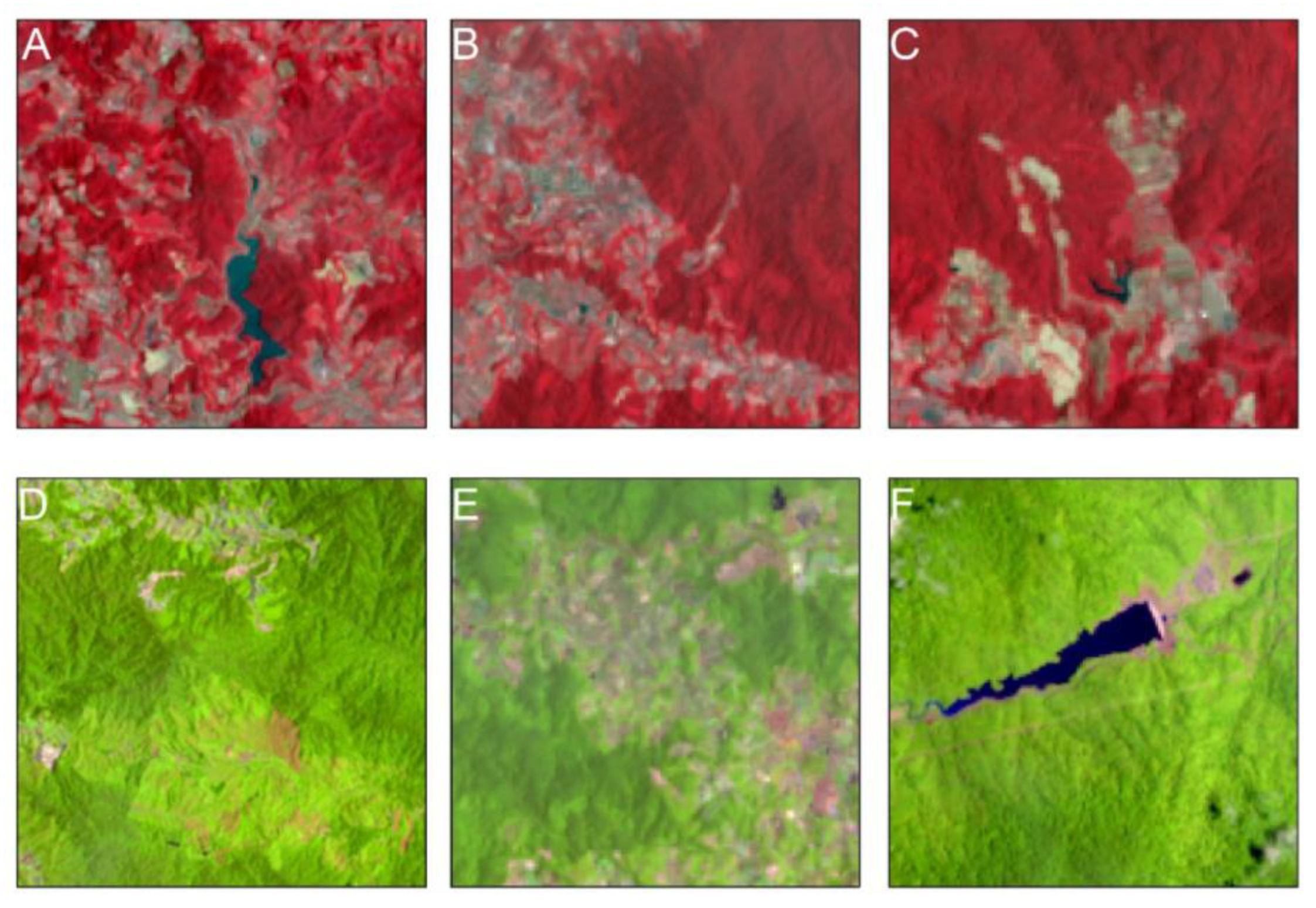


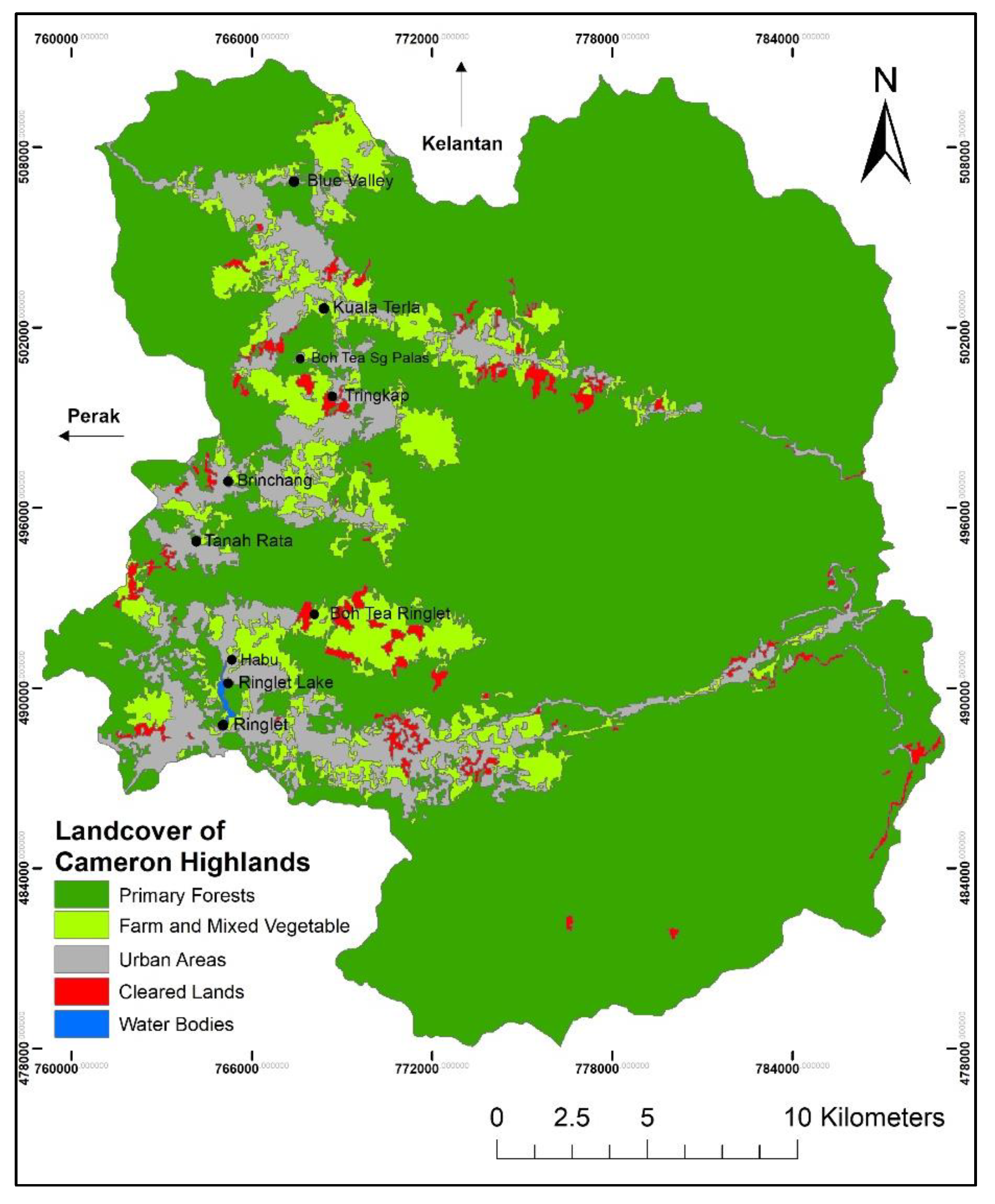
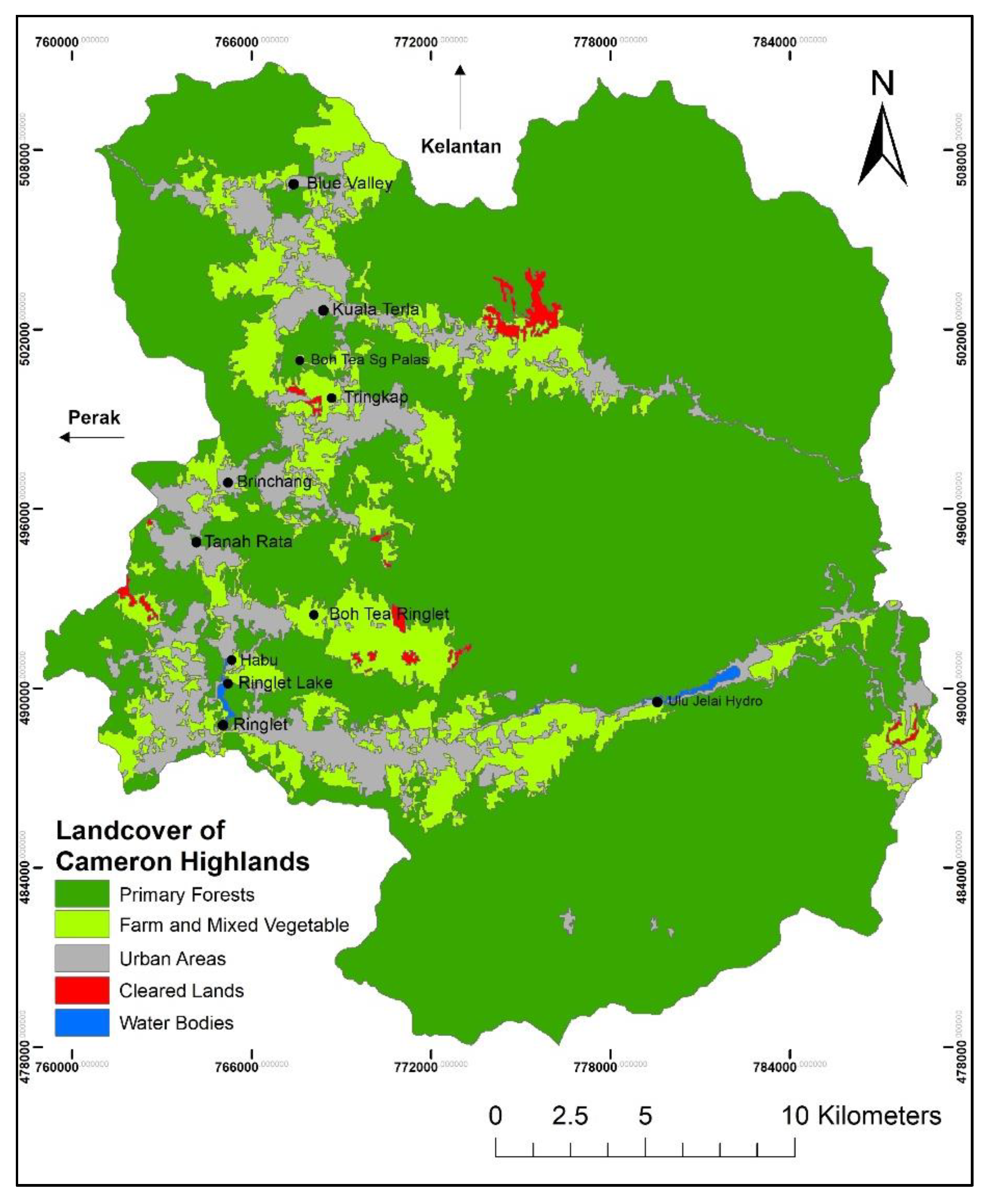
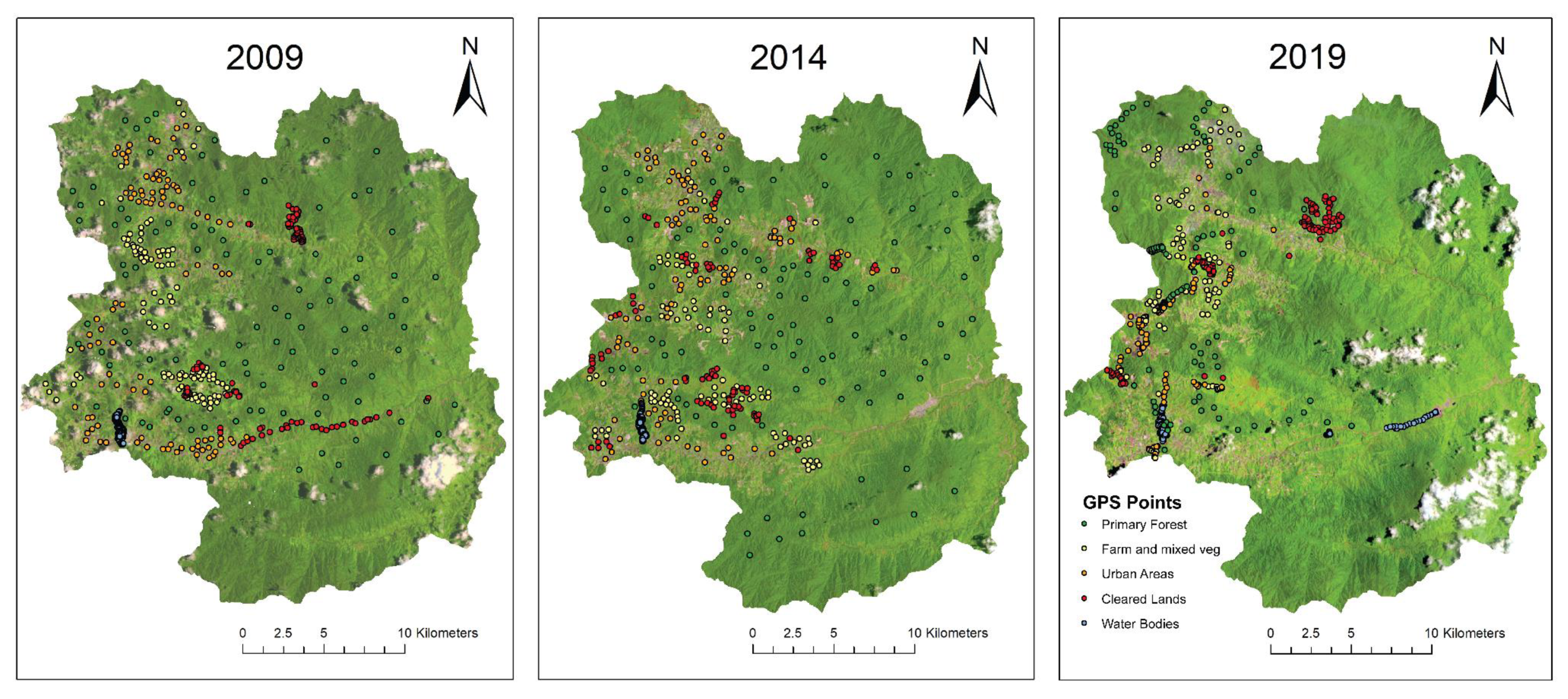
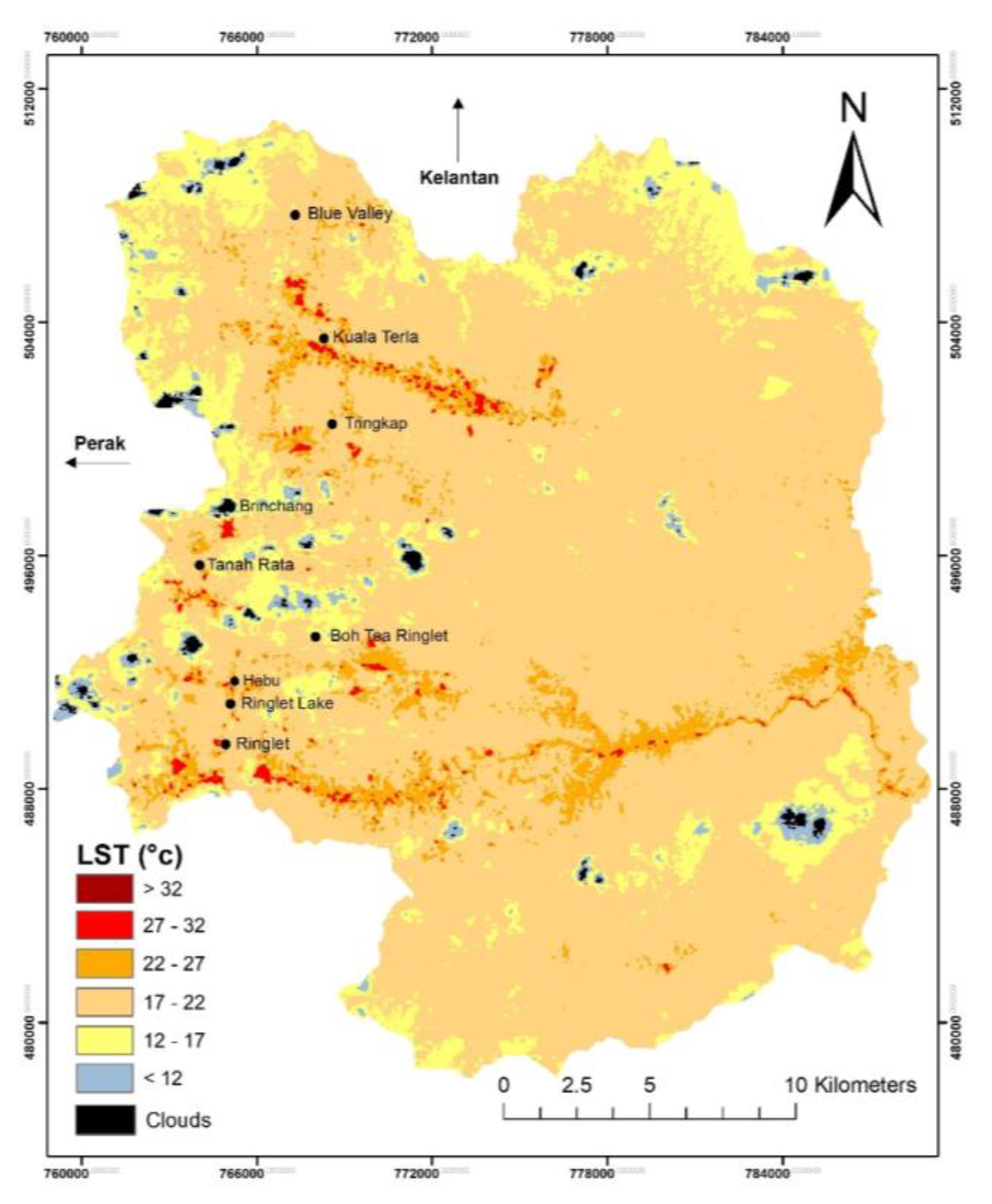
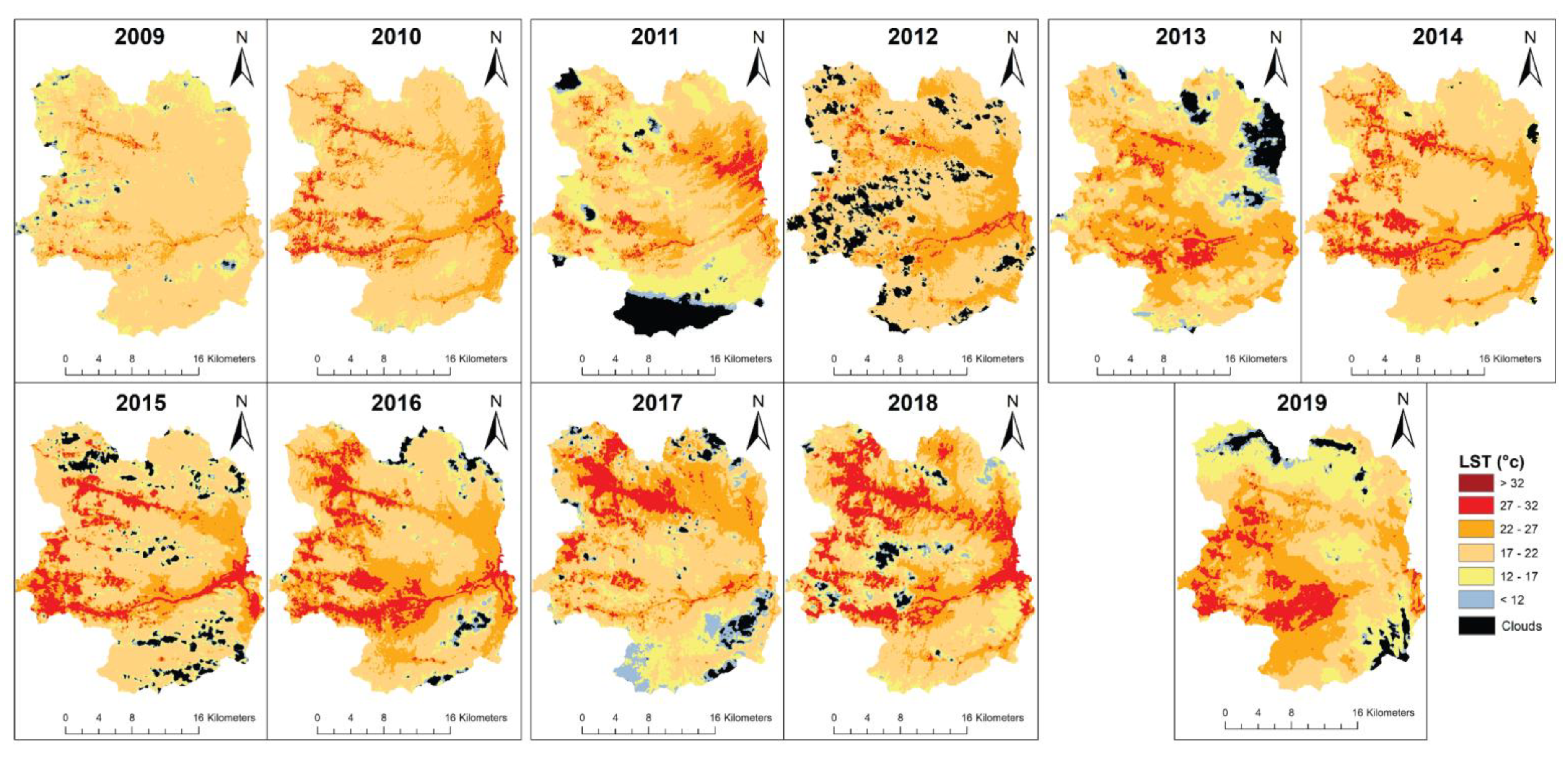
| Sensor | Date | Purpose |
|---|---|---|
| Landsat 7 (ETM+) | 03 April 2009 | Land Use and Land Surface Temperature |
| 01 February 2010 | Land Surface Temperature | |
| 20 February 2011 | Land Surface Temperature | |
| 11 April 2012 | Land Surface Temperature | |
| Landsat 8 (OLI/TIRS) | 09 June 2013 | Land Surface Temperature |
| 08 March 2014 | Land Use and Land Surface Temperature | |
| 19 June 2015 | Land Surface Temperature | |
| 14 April 2016 | Land Surface Temperature | |
| 23 August 2017 | Land Surface Temperature | |
| 30 January 2018 | Land Surface Temperature | |
| 22 March 2019 | Land Use and Land Surface Temperature | |
| MODIS TERRA MOD11A2 | 01 February 2009 | Land Surface Temperature |
| 25 January 2010 | Land Surface Temperature | |
| MODIS TERRA MOD11A2 | 20 February 2011 | Land Surface Temperature |
| 22 April 2012 | Land Surface Temperature | |
| 18 June 2013 | Land Surface Temperature | |
| 06 March 2014 | Land Surface Temperature | |
| 26 April 2015 | Land Surface Temperature | |
| 06 April 2016 | Land Surface Temperature | |
| 21 August 2017 | Land Surface Temperature | |
| 02 February 2018 | Land Surface Temperature | |
| 22 March 2019 | Land Surface Temperature |
| Land Cover Types | Description |
|---|---|
| Primary forests | Forests of native tree species, where there are no clearly visible indications of human activities and the ecological processes are not significantly disturbed. |
| Farm and mixed vegetable | Comprises of agriculture land for orchards as well as vegetative crops. |
| Urban areas | Comprises an area such as settlement areas, roads, and industries. |
| Cleared lands | Comprises various types of old-growth forests that have become so severely degraded by logging and no longer resemble the spectral signatures of forests. |
| Water bodies | Water features, including, rivers, lakes, and artificial ponds. |
| Coefficient | Value |
|---|---|
| C0 | −0.268 |
| C1 | 1.378 |
| C2 | 0.183 |
| C3 | 54.30 |
| C4 | −2.238 |
| C5 | −129.20 |
| C6 | 16.40 |
| 2009 | 2014 | 2019 | ||||
|---|---|---|---|---|---|---|
| Area (sq. km) | Area (%) | Area (sq. km) | Area (%) | Area (sq. km) | Area (%) | |
| Primary Forests | 578.15 | 86.33% | 541.76 | 80.90% | 518.71 | 77.46% |
| Farm & Mixed Veg | 33.00 | 4.93% | 57.03 | 8.52% | 84.61 | 12.63% |
| Urban Areas | 50.10 | 7.48% | 59.50 | 8.88% | 61.10 | 9.12% |
| Cleared Lands | 7.84 | 1.17% | 11.06 | 1.65% | 4.17 | 0.62% |
| Water Bodies | 0.60 | 0.09% | 0.34 | 0.05% | 1.10 | 0.16% |
| Total | 669.69 | 100.00% | 669.69 | 100.00% | 669.69 | 100.00% |
| Area between Years | 09–14 (sq. km) | % Diff | 14–19 (sq. km) | % Diff | 09–19 (sq. km) | % Diff |
|---|---|---|---|---|---|---|
| Primary Forests | (−) 36.39 | (−) 5.43% | (−) 23.05 | (−) 3.44% | (−) 59.44 | (−) 8.88% |
| Farm & Mixed Veg | (+) 24.03 | (+) 3.59% | (+) 27.58 | (+) 4.12% | (+) 51.61 | (+) 7.71% |
| Urban Areas | (+) 9.40 | (+) 1.40% | (+) 1.60 | (+) 0.24% | (+) 11.00 | (+) 1.64% |
| Cleared Lands | (+) 3.22 | (+) 0.48% | (−) 6.89 | (−) 1.03% | (−) 3.67 | (−) 0.55% |
| Water Bodies | (−) 0.26 | (−) 0.04% | (+) 0.76 | (+) 0.11% | (+) 0.50 | (+) 0.07% |
| LULCC 2019 | Cleared | Urban | Primary | Farm | Water | Total | User (%) |
|---|---|---|---|---|---|---|---|
| Cleared lands | 95 | 1 | 0 | 0 | 0 | 96 | 98.96 |
| Urban areas | 3 | 92 | 1 | 7 | 0 | 103 | 89.32 |
| Primary forests | 0 | 2 | 97 | 4 | 0 | 103 | 94.17 |
| Farm & Mixed vegetables | 2 | 5 | 2 | 89 | 0 | 98 | 90.82 |
| Water bodies | 0 | 0 | 0 | 0 | 100 | 100 | 100.00 |
| Total | 100 | 100 | 100 | 100 | 100 | 500 | 94.65 |
| Producers Accuracy (%) | 95.00 | 92.00 | 97.00 | 89.00 | 100.00 | 94.60 |
| LULCC 2014 | Cleared | Urban | Primary | Farm | Water | Total | User (%) |
|---|---|---|---|---|---|---|---|
| Cleared lands | 88 | 7 | 0 | 3 | 1 | 99 | 88.88 |
| Urban areas | 5 | 86 | 1 | 5 | 3 | 100 | 86.00 |
| Primary forests | 0 | 2 | 96 | 3 | 0 | 101 | 95.05 |
| Farm & Mixed vegetables | 8 | 1 | 3 | 88 | 0 | 100 | 88.00 |
| Water bodies | 0 | 3 | 0 | 0 | 97 | 100 | 97.00 |
| Total | 101 | 99 | 100 | 99 | 101 | 500 | 90.88 |
| Producers Accuracy (%) | 87.00 | 87.00 | 96.00 | 89.00 | 96.00 | 91.00 |
| LULCC 2009 | Cleared | Urban | Primary | Farm | Water | Total | User (%) |
|---|---|---|---|---|---|---|---|
| Cleared lands | 85 | 2 | 4 | 1 | 0 | 92 | 92.40 |
| Urban areas | 5 | 88 | 6 | 8 | 0 | 107 | 82.24 |
| Primary forests | 4 | 2 | 94 | 4 | 0 | 104 | 90.38 |
| Farm & Mixed vegetables | 2 | 5 | 2 | 89 | 0 | 98 | 90.82 |
| Water bodies | 0 | 1 | 0 | 0 | 98 | 99 | 98.99 |
| Total | 96 | 98 | 106 | 102 | 98 | 500 | 90.96 |
| Producers Accuracy (%) | 95.00 | 92.00 | 97.00 | 89.00 | 100.00 | 94.60 |
| Temperature Platform (°C) | |||||||||||
|---|---|---|---|---|---|---|---|---|---|---|---|
| Landsat (100 m) | MODIS (1 km) | Met Malaysia | |||||||||
| Year | Month | Max | Min | Mean | SD | Max | Min | Mean | SD | Max | Min |
| 2009 | March | 30.5 | 7.0 | 18.5 | 2.0 | 29.7 | 20.2 | 25.1 | 1.5 | 25.1 | 13.0 |
| 2010 | February | 34.4 | 15.7 | 21.3 | 1.6 | 28.5 | 21.0 | 24.3 | 1.4 | 24.8 | 13.0 |
| 2011 | February | 26.0 | 11.0 | 15.1 | 4.8 | 29.0 | 12.4 | 20.9 | 3.3 | 24.6 | 12.1 |
| 2012 | April | 36.6 | 9.0 | 19.8 | 3.5 | 28.2 | 12.2 | 24.6 | 1.6 | 24.4 | 14.2 |
| 2013 | June | 25.4 | 5.4 | 14.9 | 4.1 | 28.4 | 19.9 | 24.3 | 1.5 | 25.9 | 14.6 |
| 2014 | March | 40.9 | 13.8 | 23.4 | 1.9 | 31.1 | 22.0 | 25.6 | 1.5 | 25.5 | 11.8 |
| 2015 | April | 30.0 | 12.7 | 20.7 | 2.2 | 27.6 | 20.3 | 24.0 | 1.1 | 25.2 | 15.0 |
| 2016 | April | 34.7 | 12.1 | 23.9 | 2.1 | 32.0 | 22.0 | 26.7 | 1.8 | 26.4 | 15.1 |
| 2017 | August | 27.7 | 8.2 | 17.2 | 2.0 | 28.3 | 16.2 | 23.3 | 1.5 | 24.6 | 14.5 |
| 2018 | January | 33.7 | 9.4 | 20.5 | 2.0 | 31.0 | 14.1 | 24.3 | 2.2 | 24.5 | 13.9 |
| 2019 | March | 31.0 | 0.5 | 18.2 | 4.1 | 30.5 | 11.0 | 25.1 | 2.5 | 25.3 | 14.2 |
| Temperature Platform (°C) | |||||||
|---|---|---|---|---|---|---|---|
| Landsat/MODIS | Met Malaysia/Landsat | Met Malaysia/MODIS | |||||
| Year | Month | Max | Min | Max | Min | Max | Min |
| 2009 | March | 0.8 | −13.2 | −5.4 | 6.0 | −4.6 | −7.2 |
| 2010 | February | 5.9 | −5.3 | −9.6 | −2.7 | −3.7 | −8.0 |
| 2011 | February | −3.0 | −1.4 | −1.4 | 1.1 | −4.4 | −0.3 |
| 2012 | April | 8.4 | −3.2 | −12.2 | 5.2 | −3.8 | 2.0 |
| 2013 | June | −3.0 | −14.5 | 0.5 | 9.2 | −2.5 | −5.3 |
| 2014 | March | 9.8 | −8.2 | −15.4 | −2.0 | −5.6 | −10.2 |
| 2015 | April | 2.4 | −7.6 | −4.8 | 2.3 | −2.4 | −5.3 |
| 2016 | April | 2.7 | −9.9 | −8.3 | 3.0 | −5.6 | −6.9 |
| 2017 | August | −0.6 | −8.0 | −3.1 | 6.3 | −3.7 | −1.7 |
| 2018 | January | −9.7 | −8.4 | 3.2 | 8.2 | −6.5 | −0.2 |
| 2019 | March | 0.5 | −10.5 | −5.7 | 13.7 | −5.2 | 3.2 |
| Average Difference | 1.3 | −8.2 | −5.6 | 4.6 | −4.4 | −3.6 | |
| LST Landsat–MODIS | LST MODIS–MetMY | LST Landsat–MetMY | |||||||||
|---|---|---|---|---|---|---|---|---|---|---|---|
| Max | Min | Max | Min | Max | Min | ||||||
| RMSE | Bias | RMSE | Bias | RMSE | Bias | RMSE | Bias | RMSE | Bias | RMSE | Bias |
| 4.68 | 2.41 | 8.76 | −7.86 | 4.53 | 4.36 | 5.56 | 3.62 | 8.13 | 6.80 | 6.19 | −4.20 |
© 2020 by the authors. Licensee MDPI, Basel, Switzerland. This article is an open access article distributed under the terms and conditions of the Creative Commons Attribution (CC BY) license (http://creativecommons.org/licenses/by/4.0/).
Share and Cite
How Jin Aik, D.; Ismail, M.H.; Muharam, F.M. Land Use/Land Cover Changes and the Relationship with Land Surface Temperature Using Landsat and MODIS Imageries in Cameron Highlands, Malaysia. Land 2020, 9, 372. https://doi.org/10.3390/land9100372
How Jin Aik D, Ismail MH, Muharam FM. Land Use/Land Cover Changes and the Relationship with Land Surface Temperature Using Landsat and MODIS Imageries in Cameron Highlands, Malaysia. Land. 2020; 9(10):372. https://doi.org/10.3390/land9100372
Chicago/Turabian StyleHow Jin Aik, Darren, Mohd Hasmadi Ismail, and Farrah Melissa Muharam. 2020. "Land Use/Land Cover Changes and the Relationship with Land Surface Temperature Using Landsat and MODIS Imageries in Cameron Highlands, Malaysia" Land 9, no. 10: 372. https://doi.org/10.3390/land9100372
APA StyleHow Jin Aik, D., Ismail, M. H., & Muharam, F. M. (2020). Land Use/Land Cover Changes and the Relationship with Land Surface Temperature Using Landsat and MODIS Imageries in Cameron Highlands, Malaysia. Land, 9(10), 372. https://doi.org/10.3390/land9100372




